( ESNUG 537 Item 4 ) -------------------------------------------- [02/28/14]
Subject: Mark Wallace of Cavium's Jasper User Group (JUG'13) Trip Report
> - The Jasper User Group Meeting is coming up on Oct. 22-23 at the
> Cypress Hotel in Cupertino, CA. They'll be having user-lead
> Birds-of-a-Feathers on: Proof Grids, Property synthesis, IP-XACT,
> Clock & Reset Set-up and verification, Low power verification,
> AMBA Proofkit, Protocol verification, Security path verification.
>
> - from http://www.deepchip.com/items/0528-04.html
From: [ Mark Wallace of Cavium ]
Hi John,
This is a trip report about my experiences at the Jasper User Group meeting
(JUG 2013), which was held in Silicon Valley towards the end of October.
I am a Senior Design Verification Engineer at Cavium in San Jose. I work
closely with designers to verify internal blocks as well as system-level
scenarios in the network chips.
The two-day meeting covered 14 user presentations and five presentations by
Jasper R&D, together with 8 user-led "birds-of-a-feather" discussions and 7
demo stations.
The user presentations were from: Applied Micro, ARM, Broadcom, Juniper
Networks, Nvidia, Samsung, Sony, and STMicroelectronics, and two "must read"
presentations for new formal users. The 5 Jasper presentations covered low
power verification, security verification, coverage, debugging, and
behavioral property synthesis. Around 150 user attended, from the U.S,
Europe, and Japan.
Offices in Mountain View / Sweden/ Brazil / Israel
130 employees, 70 in R&D
Many are PhD's and experts in formal
Highest # of formal R&D in EDA; >3X nearest competitor
The user-led birds-of-a-feather sessions covered low power verification;
security verification; protocol verification; property synthesis; coverage;
clock/reset verification; IP-XACT; efficient allocation of properties,
proof engines and licenses across available compute resources, using
Jasper's ProofGrid.
USER PRESENTATIONS
- APPLIED MICRO Keith Schakel gave an excellent primer on adopting and
using formal verification - one of the two "must reads" for new formal
users. It covered:
Inputs to JasperGold
Outputs from JasperGold
State definition
State space
Reachable and unreachable states
Full proofs
Counterexamples
Bounded proofs
State space explosion
Underconstraining
Overconstraining
Coverage
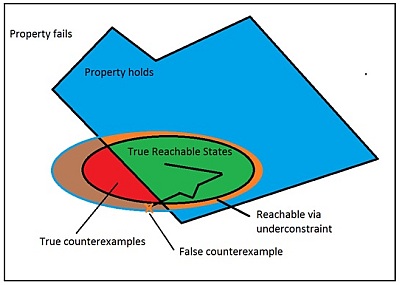 Concluded with "Counter-intuitive Truths About Formal" rundown:
Free inputs automatically take every possible value, every
combination of values, and every sequence of every possible
combination of values; testbenches are unnecessary for
formal; and proofs are valid even if huge chunks of the
design are abstracted away.
---- ---- ---- ---- ---- ---- ----
- ARM Laurent Arditi showed how they used Jasper formal - mostly at
the top level - to verify the Cortex A12 in Jira. Jasper found
25 percent of the 963 real bugs, but constituted only 10 percent
of the total verification effort.
Concluded with "Counter-intuitive Truths About Formal" rundown:
Free inputs automatically take every possible value, every
combination of values, and every sequence of every possible
combination of values; testbenches are unnecessary for
formal; and proofs are valid even if huge chunks of the
design are abstracted away.
---- ---- ---- ---- ---- ---- ----
- ARM Laurent Arditi showed how they used Jasper formal - mostly at
the top level - to verify the Cortex A12 in Jira. Jasper found
25 percent of the 963 real bugs, but constituted only 10 percent
of the total verification effort.
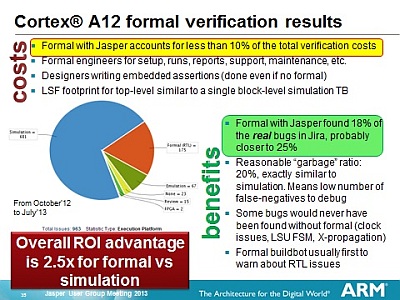 Some bugs, such as clock issues, X-propagation and load store unit
(LSU) FSM bugs would never have been found by simulation. The
presentation showed how formal can "please your project manager,
too" by significantly boosting verification ROI.
---- ---- ---- ---- ---- ---- ----
- ARM Alex Netterville showed how they used Jasper's formal apps to
verify the memory interfaces for a new processor design (Pelican).
Some bugs, such as clock issues, X-propagation and load store unit
(LSU) FSM bugs would never have been found by simulation. The
presentation showed how formal can "please your project manager,
too" by significantly boosting verification ROI.
---- ---- ---- ---- ---- ---- ----
- ARM Alex Netterville showed how they used Jasper's formal apps to
verify the memory interfaces for a new processor design (Pelican).
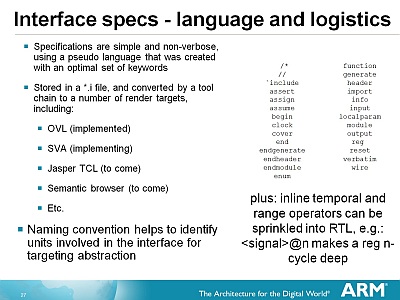 This enabled ARM to test a functional unit in its own unit-level
formal bench, isolated from the rest of the design; to run top-level
formal to check the interactions of all functional units; and to use
black-box abstraction to verify a functional unit within a "whole
design" context. The team used Jasper's Visualize tool to analyze
interface models, both in checking expected interface specification
behavior and in exploring back-to-back request patterns.
---- ---- ---- ---- ---- ---- ----
- BROADCOM Shuqing Zhao described using formal to detect X-propagation
in a power management controller for a quad-core processor. They used
formal reset analysis to detect uninitialized flip-flops and Jasper's
X-Propagation Verification App to analyze the identified RTL blocks.
This enabled ARM to test a functional unit in its own unit-level
formal bench, isolated from the rest of the design; to run top-level
formal to check the interactions of all functional units; and to use
black-box abstraction to verify a functional unit within a "whole
design" context. The team used Jasper's Visualize tool to analyze
interface models, both in checking expected interface specification
behavior and in exploring back-to-back request patterns.
---- ---- ---- ---- ---- ---- ----
- BROADCOM Shuqing Zhao described using formal to detect X-propagation
in a power management controller for a quad-core processor. They used
formal reset analysis to detect uninitialized flip-flops and Jasper's
X-Propagation Verification App to analyze the identified RTL blocks.
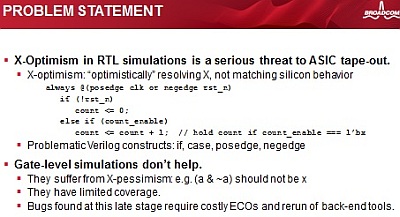 It detected 4 flip-flops that were not initialized by reset, despite
prior "comprehensive" UVM-constrained random simulation. It also
detected one flop that caused a "nasty bug" in the state-machine
transition after reset.
---- ---- ---- ---- ---- ---- ----
- BROADCOM William Su highlighted the different outcomes in applying
constraints in formal vs. simulation - the 2nd of the two "must reads"
for new formal users. Using the formal results from 4 case studies
in live projects, the presentation concluded that "less is more."
It detected 4 flip-flops that were not initialized by reset, despite
prior "comprehensive" UVM-constrained random simulation. It also
detected one flop that caused a "nasty bug" in the state-machine
transition after reset.
---- ---- ---- ---- ---- ---- ----
- BROADCOM William Su highlighted the different outcomes in applying
constraints in formal vs. simulation - the 2nd of the two "must reads"
for new formal users. Using the formal results from 4 case studies
in live projects, the presentation concluded that "less is more."
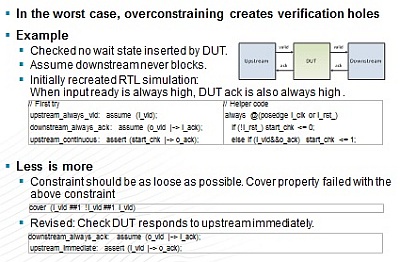 In contrast to a constrained-random testbench, where more constraints
can aid bug detection, over-constraining a formal tool can have the
opposite result, significantly limiting its ability to explore the
state space and to detect corner case bugs. In the worst case, over-
constraining can leave verification holes. The presentation showed
that it was easier to achieve convergence by
(a) using fewer constraints
and
(b) using cover properties to determine which functionality
has been covered.
---- ---- ---- ---- ---- ---- ----
- BROADCOM Normando Montecillo won "best paper" award for his talk on
an innovative use of Jasper's Scoreboard proof accelerator. The task
was to verify a design-under-test (DUT) that had the legal ability to
occasionally throw away data. In the conventional use of Scoreboard,
all input data must appear at the outputs, and there is no means to
remove data that has been input to the tool.
In contrast to a constrained-random testbench, where more constraints
can aid bug detection, over-constraining a formal tool can have the
opposite result, significantly limiting its ability to explore the
state space and to detect corner case bugs. In the worst case, over-
constraining can leave verification holes. The presentation showed
that it was easier to achieve convergence by
(a) using fewer constraints
and
(b) using cover properties to determine which functionality
has been covered.
---- ---- ---- ---- ---- ---- ----
- BROADCOM Normando Montecillo won "best paper" award for his talk on
an innovative use of Jasper's Scoreboard proof accelerator. The task
was to verify a design-under-test (DUT) that had the legal ability to
occasionally throw away data. In the conventional use of Scoreboard,
all input data must appear at the outputs, and there is no means to
remove data that has been input to the tool.
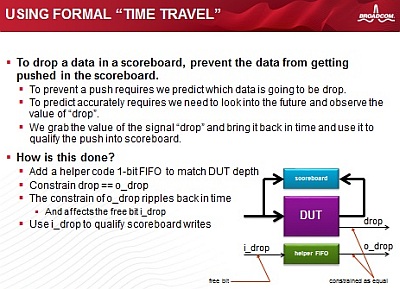 To identify data that should be prevented from entering the tool, the
team devised an approach in which the tool's output is constrained to
observe the data to be dropped. These values are then used to qualify
the data input to the tool. "This technique appears to defy logic and
causality in the simulation world, but works in the formal world.
There are more clever techniques waiting to be discovered, we just
need to remove some of our preconceived boundaries."
---- ---- ---- ---- ---- ---- ----
- JUNIPER Rohit Date used the Jasper Connectivity Verification App for
the verification of BIST repair in a chip with 5,000 SRAM instances.
To identify data that should be prevented from entering the tool, the
team devised an approach in which the tool's output is constrained to
observe the data to be dropped. These values are then used to qualify
the data input to the tool. "This technique appears to defy logic and
causality in the simulation world, but works in the formal world.
There are more clever techniques waiting to be discovered, we just
need to remove some of our preconceived boundaries."
---- ---- ---- ---- ---- ---- ----
- JUNIPER Rohit Date used the Jasper Connectivity Verification App for
the verification of BIST repair in a chip with 5,000 SRAM instances.
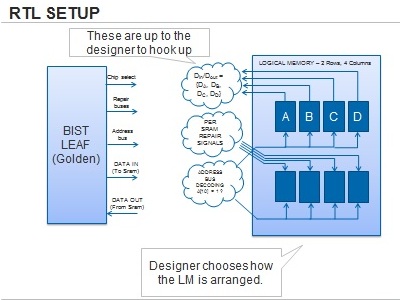 They had decided against simulation because of its laborious flow and
long run/debug times. Juniper chose formal because of its ability to
verify each connection's property in isolation and its strong
correlation between property and bug, yielding faster turnaround and
debug. The team found 7 critical bugs in 2 months. Deployment time
was 6 weeks, including devising the parameters of the flow, building
the flow, running pilot test cases, and using the results to perfect
the flow to ensure that it would work on all blocks. The flow was
developed towards the end of the design schedule, but is reusable on
a "verify as you go" basis in future projects.
---- ---- ---- ---- ---- ---- ----
- JUNIPER Anamaya Sullerey presented the bring-up and verification of a
load balancer. Simulation was used as the sign-off method, so only
a limited amount of time was allocated to formal verification.
They had decided against simulation because of its laborious flow and
long run/debug times. Juniper chose formal because of its ability to
verify each connection's property in isolation and its strong
correlation between property and bug, yielding faster turnaround and
debug. The team found 7 critical bugs in 2 months. Deployment time
was 6 weeks, including devising the parameters of the flow, building
the flow, running pilot test cases, and using the results to perfect
the flow to ensure that it would work on all blocks. The flow was
developed towards the end of the design schedule, but is reusable on
a "verify as you go" basis in future projects.
---- ---- ---- ---- ---- ---- ----
- JUNIPER Anamaya Sullerey presented the bring-up and verification of a
load balancer. Simulation was used as the sign-off method, so only
a limited amount of time was allocated to formal verification.
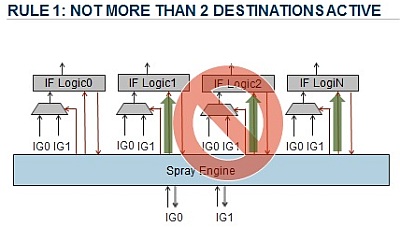 The team detected most of the bugs/issues with 9 basic properties,
saving many weeks of simulation-based discovery and debug time. The
first implementation of the load balancer took 3 days to verify, with
each bug taking only a couple of hours to find and debug. However,
verification of the circuit after architecture modification was much
faster because the properties and infrastructure remained the same.
Although the original goal was to use formal verification only as a
"first line of defense," subsequent simulation found no further bugs.
---- ---- ---- ---- ---- ---- ----
- NVIDIA Scott Xu described how they took just 10 hours to verify the
connectivity on a multicore SoC, using Jasper formal. There were
40,000 paths, with registers and asynchronous FIFOs along the paths,
and 150 clocks. The team reported Jasper has "good performance, easy
setup, easy debug, and good local support." They also noted that
Jasper has a customized function for reverse connectivity extraction.
The team detected most of the bugs/issues with 9 basic properties,
saving many weeks of simulation-based discovery and debug time. The
first implementation of the load balancer took 3 days to verify, with
each bug taking only a couple of hours to find and debug. However,
verification of the circuit after architecture modification was much
faster because the properties and infrastructure remained the same.
Although the original goal was to use formal verification only as a
"first line of defense," subsequent simulation found no further bugs.
---- ---- ---- ---- ---- ---- ----
- NVIDIA Scott Xu described how they took just 10 hours to verify the
connectivity on a multicore SoC, using Jasper formal. There were
40,000 paths, with registers and asynchronous FIFOs along the paths,
and 150 clocks. The team reported Jasper has "good performance, easy
setup, easy debug, and good local support." They also noted that
Jasper has a customized function for reverse connectivity extraction.
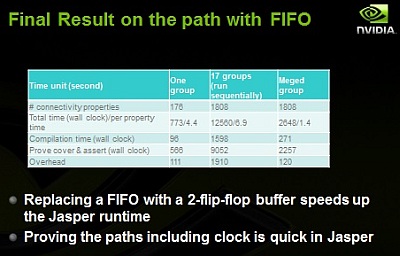 Despite using 40 simulation licenses per job, simulation could not
cover all source signals; and could not verify all registers and
asynchronous FIFOs; and could not check time latency from source to
destination. They said Cadence IFV could not support parallel
processing of their 40,000+ properties. Even after partitioning
the verification tasks, IFV's regression time was still more than
3 days, and it was difficult to debug.
---- ---- ---- ---- ---- ---- ----
- NVIDIA Homayoon Akhiani used JG-COV App's reset analysis and debug
to find the logic that takes the longest time to reset.
Despite using 40 simulation licenses per job, simulation could not
cover all source signals; and could not verify all registers and
asynchronous FIFOs; and could not check time latency from source to
destination. They said Cadence IFV could not support parallel
processing of their 40,000+ properties. Even after partitioning
the verification tasks, IFV's regression time was still more than
3 days, and it was difficult to debug.
---- ---- ---- ---- ---- ---- ----
- NVIDIA Homayoon Akhiani used JG-COV App's reset analysis and debug
to find the logic that takes the longest time to reset.
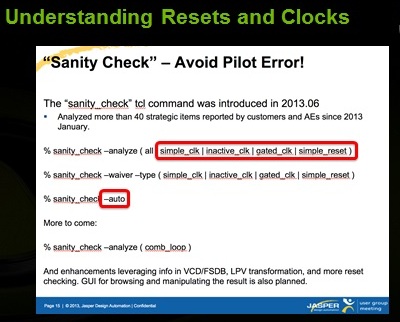 With the help of appropriate black boxing, the team systematically
analyzed the SoC design to identify long-delay resets, enabling them
to devise a less time-consuming reset methodology. The team also
used Jasper's Visualize, which automatically generates waveforms
without the need for a testbench. The methodology found reset
problems missed by simulation (by extra-long resets), and some
gated clocks that did not clock during reset.
---- ---- ---- ---- ---- ---- ----
- NVIDIA Syed Suhaib used Jasper Sequential Equivalency Checking (SEC)
App to verify clock-gating schemes used in dynamic power reduction.
He emphasized that clock-gating verification is often left until
late in the design, and inadequate verification can mean "lights out"
for large sections of the chip; severe violation of the power specs;
costly engineering change orders (ECOs); and even re-spins.
With the help of appropriate black boxing, the team systematically
analyzed the SoC design to identify long-delay resets, enabling them
to devise a less time-consuming reset methodology. The team also
used Jasper's Visualize, which automatically generates waveforms
without the need for a testbench. The methodology found reset
problems missed by simulation (by extra-long resets), and some
gated clocks that did not clock during reset.
---- ---- ---- ---- ---- ---- ----
- NVIDIA Syed Suhaib used Jasper Sequential Equivalency Checking (SEC)
App to verify clock-gating schemes used in dynamic power reduction.
He emphasized that clock-gating verification is often left until
late in the design, and inadequate verification can mean "lights out"
for large sections of the chip; severe violation of the power specs;
costly engineering change orders (ECOs); and even re-spins.
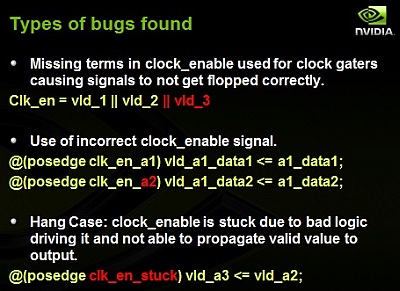 NVIDIA used the SEC App to compare IP blocks free of clock-gating with
their clock-gated versions. They said the App implemented a 15 minute
automatic mapping of the two designs' I/O, and automatic generation of
all requisite assertions. Debug was straightforward because the App's
GUI places the two DUT instances side-by-side, making mismatches
obvious to identify and debug. The 20 man team created a script which
automatically plotted the mismatches between signals until the first
failure was found. The SEC App found 41 clock gating bugs, 50% of
which were found after supposedly high-coverage simulation.
The presenter said simulation was "necessary but not sufficient."
---- ---- ---- ---- ---- ---- ----
- SAMSUNG Joanna Zhang showed how they used formal verification to devise
an automated flow to verify a CPU interrupt scheme consisting of 200
interrupt lines. Instead of manually writing 200 assertions, the team
used Jasper's Visualize tool to generate waveforms for each interrupt.
NVIDIA used the SEC App to compare IP blocks free of clock-gating with
their clock-gated versions. They said the App implemented a 15 minute
automatic mapping of the two designs' I/O, and automatic generation of
all requisite assertions. Debug was straightforward because the App's
GUI places the two DUT instances side-by-side, making mismatches
obvious to identify and debug. The 20 man team created a script which
automatically plotted the mismatches between signals until the first
failure was found. The SEC App found 41 clock gating bugs, 50% of
which were found after supposedly high-coverage simulation.
The presenter said simulation was "necessary but not sufficient."
---- ---- ---- ---- ---- ---- ----
- SAMSUNG Joanna Zhang showed how they used formal verification to devise
an automated flow to verify a CPU interrupt scheme consisting of 200
interrupt lines. Instead of manually writing 200 assertions, the team
used Jasper's Visualize tool to generate waveforms for each interrupt.
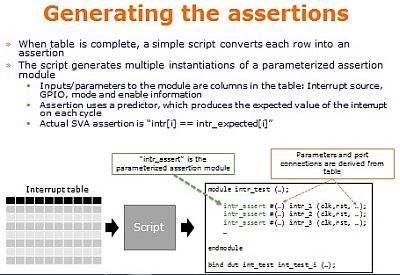 The team then used the data in tabular form, together with a simple
script, to automatically generate the assertions. The assertions
detected incorrect reset values and missing synchronizers. This took
as long as using manually-written assertions, but will deliver time
and effort savings in its future reuse on modified and new RTL code.
---- ---- ---- ---- ---- ---- ----
- SONY Kenta Ono described how they applied Jasper formal to verify a
complex timing generation block, parts of which are reused in multiple
designs. Formal got 100% functional coverage with a 25% cut in human
effort vs. simulation, which never hit the required coverage.
The team then used the data in tabular form, together with a simple
script, to automatically generate the assertions. The assertions
detected incorrect reset values and missing synchronizers. This took
as long as using manually-written assertions, but will deliver time
and effort savings in its future reuse on modified and new RTL code.
---- ---- ---- ---- ---- ---- ----
- SONY Kenta Ono described how they applied Jasper formal to verify a
complex timing generation block, parts of which are reused in multiple
designs. Formal got 100% functional coverage with a 25% cut in human
effort vs. simulation, which never hit the required coverage.
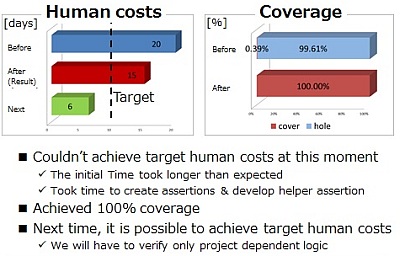 The team expects more reductions in human effort because the re-usable
parts of the design can now be deployed without further verification.
They were a relative newcomer to formal verification.
---- ---- ---- ---- ---- ---- ----
- STMICRO: This case study (presented by a stand-in from Jasper) showed
how they used Jasper's Low Power Verification App to verify interface
slices and signals on an ARM-based quad-core CPU sub-system with
multiple power domains. Power verification started a few weeks from
tapeout, so they used existing assertion-based verification IP from
Jasper - Intelligent Proof Kits for ACE, AX13, APB and ATB. They also
used Jasper's Power Sequencer and Scoreboard proof accelerators.
Exhaustive verification identified problems with some clamp values in
the first hour of the first verification run. The team went on to
verify the low power aspects of ACE, AX13, APB and ATB interface slices
for protocol correctness and data integrity in all valid power states.
The team -- whose members were relatively new to formal methods -- said
that environment setup was fast, and that the reuse of power-aware
properties for future projects/derivatives would be easy.
---- ---- ---- ---- ---- ---- ----
---- ---- ---- ---- ---- ---- ----
---- ---- ---- ---- ---- ---- ----
My take-away: The two days gave me a good overview of the breadth and depth
of the use of Jasper formal. The meeting was highly interactive, and the
exchange of important "how to" information with fellow users and Jasper R&D
spanned the whole range of functional verification challenges.
For me, JUG is definitely a "mark your calendar" event. Although it would
have also been a good introduction to formal on its own, it also helped that
I had participated in a 1 month formal eval just two months before. Even
with my limited eval experience I was able to ask additional questions and
the Jasper AEs helped by carrying me to additional points of interest.
Over the next year I would like to eval IP-XACT and the Security Apps that
Jasper has. From the birds-of-a-feather discussion on IP-XACT, I saw how
others used the tool to improve register verification and documentation.
From their Security App demo, I got an idea how it might help verify
datapath security.
- Mark Wallace
Cavium, Inc. San Jose, CA
The team expects more reductions in human effort because the re-usable
parts of the design can now be deployed without further verification.
They were a relative newcomer to formal verification.
---- ---- ---- ---- ---- ---- ----
- STMICRO: This case study (presented by a stand-in from Jasper) showed
how they used Jasper's Low Power Verification App to verify interface
slices and signals on an ARM-based quad-core CPU sub-system with
multiple power domains. Power verification started a few weeks from
tapeout, so they used existing assertion-based verification IP from
Jasper - Intelligent Proof Kits for ACE, AX13, APB and ATB. They also
used Jasper's Power Sequencer and Scoreboard proof accelerators.
Exhaustive verification identified problems with some clamp values in
the first hour of the first verification run. The team went on to
verify the low power aspects of ACE, AX13, APB and ATB interface slices
for protocol correctness and data integrity in all valid power states.
The team -- whose members were relatively new to formal methods -- said
that environment setup was fast, and that the reuse of power-aware
properties for future projects/derivatives would be easy.
---- ---- ---- ---- ---- ---- ----
---- ---- ---- ---- ---- ---- ----
---- ---- ---- ---- ---- ---- ----
My take-away: The two days gave me a good overview of the breadth and depth
of the use of Jasper formal. The meeting was highly interactive, and the
exchange of important "how to" information with fellow users and Jasper R&D
spanned the whole range of functional verification challenges.
For me, JUG is definitely a "mark your calendar" event. Although it would
have also been a good introduction to formal on its own, it also helped that
I had participated in a 1 month formal eval just two months before. Even
with my limited eval experience I was able to ask additional questions and
the Jasper AEs helped by carrying me to additional points of interest.
Over the next year I would like to eval IP-XACT and the Security Apps that
Jasper has. From the birds-of-a-feather discussion on IP-XACT, I saw how
others used the tool to improve register verification and documentation.
From their Security App demo, I got an idea how it might help verify
datapath security.
- Mark Wallace
Cavium, Inc. San Jose, CA
Join
Index
Next->Item
|
|



